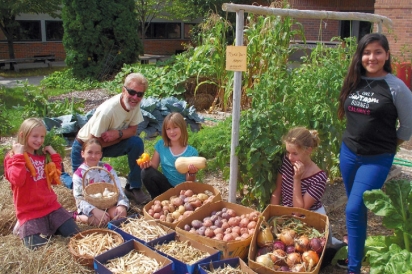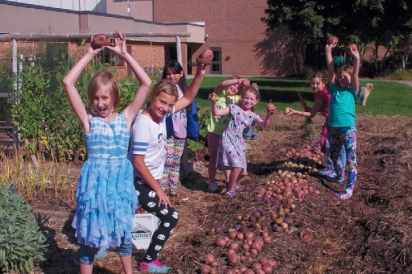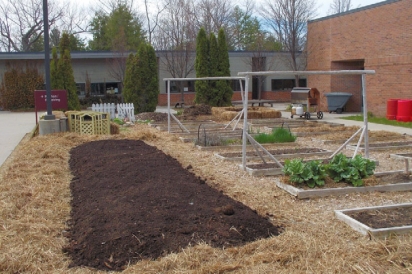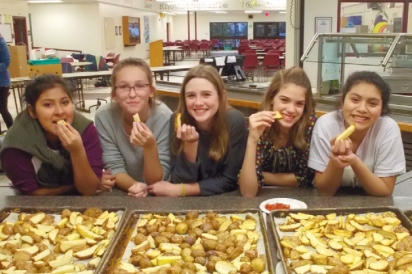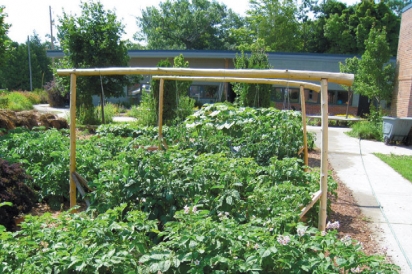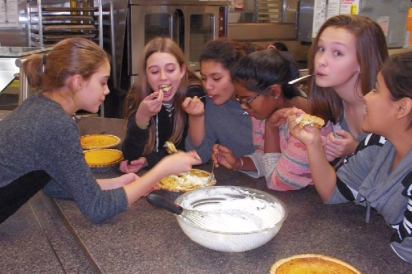Northern School Garden: A Recipe for Success
What happens when a lifelong gardener volunteers to build and maintain a vegetable garden at the local school? The kids might have fun, try new healthy foods or form a club, that’s what. In other words, it’s a recipe for success.
When considering school gardens in our northern climate, an obvious question arises: “What happens to the garden when the students leave for summer?” When we started the Leland Public School garden 11 years ago, I had a few solutions.
First, we grow only crops to be harvested after school resumes. Second, we employ methods that make for a maintenance-free garden all summer. Namely, garden paths are covered with landscape fabric, which is then covered with mulch, making for weed-free paths! The beds themselves are heavily mulched with old straw, keeping moisture in and weeds down. I live down the street and check on the garden regularly in the summer months, but it takes little care.
This year we formed an after-school garden club consisting of five fifth-grade girls. The small number made it easy to keep everyone engaged and we had no trouble getting all the work done meeting one or two days a week and using hand tools. And we had lots of fun!
Our best crops are potatoes and dry beans, as both offer opportunities to include lots of kids in the harvest. I’ll approach small groups of kids as they pass by the garden on their way to the playground. “You guys want to help dig potatoes?” Blank stares, then, “Um, OK.” As soon as the first spuds get forked up, an Easter-egg-hunt frenzy breaks out—it never fails. Dry beans are shucked and shelled by the younger classrooms and they love it and do a great job.
We also grew carrots, onions, red cabbage, chard, garlic, winter squash, popcorn and heirloom tomatoes (I harvest and dry any that ripen before school starts).
The mission of the garden is to then cook and share the food with as many students as possible. This year we formed an after-school cooking club with six eager middle-schoolers. We made “pumpkin” pies (with squash), chard quiche and huevos rancheros (beans with eggs, avocado and salsa). Potatoes were roasted, mashed, stir-fried and made into pancakes. We also juiced 25 pounds of carrots and served it to 75 kids who drank it, eagerly. They are quite brave about trying and liking new things when in a group.
We shelled and made popcorn, and cooked and sweetened armloads of rhubarb into kind of a pudding. This was a big hit!
Soon we will soak, sprout and cook beans into a hearty soup with squash, onion and dried heirloom tomatoes. Oh, and of course there is burrito day!
For my part in the garden, I was there to get things started the first two years, then the school took over. But teachers have a lot on their plates and seven years later the garden was showing signs of neglect, so I eagerly stepped back in. Now it feels like we’re just getting started. We expanded the garden this year and plan to put in a Concord grape arbor next year. We considered certain fruit trees, but trees can be fussy and often require some kind of sprays for their pests—best to leave those out of the schoolyard. I have a grape arbor in my yard that is fantastically productive and I take most of the grapes up to the school where they are wildly appreciated by the kids. How much more fun it will be to have them growing right at the school!
I’m an avid gardener myself (I try to grow my diet). I feel fortunate to have something to pass on, as well as the time and passion to do so. It helps that I truly enjoy kids.
Gandhi said we should “be the change we wish to see in the world.” I guess I’d like to live in a world of careful gardeners. It takes a village.



